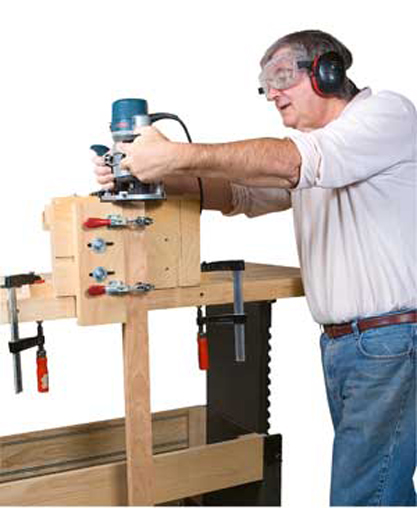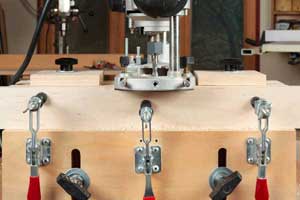“I have an obscene amount of routers – it might be close to 50,” says Bill Hylton. That’s probably not surprising, coming from the author of such well-known woodworking resources as the books Woodworking with the Router and Router Magic.
Bill even still has his first router, a Black and Decker with the same base configuration as the DeWalt 610 that he purchased reconditioned back in the 1980s. “I find it hard to part with anything,” Bill said. “I tend to say, ‘Well, this may come in handy down the road.'”
The handiness of the router itself is largely what appeals to Bill about the tool. The hand plane, for instance, Bill says, really “one does one thing. If I get a router and some bits, I can do 15 different things.”
And, while Bill thinks that anyone can master hand cutting dovetails, or the use of hand tools like a spokeshave or a chisel, he notes that that can take a lot of time and patience. With the router, “for someone who didn’t have endless patience and time to practice, it wasn’t that hard to master. If I have limited time – maybe one weekend a month and a couple of evenings a week – it’s a whole lot more productive to rout dovetails and make the drawers I want, as opposed to investing lots and lots of hours learning how to do just one thing.”
Bill himself learned how to use the router as someone who was a do-it-yourselfer who got into woodworking through his job at the time. He was working in the 1980s as a book editor at Rodale Press, mostly on gardening topics, and “a book on routers seemed to be a good topic to me. I scouted around trying to find people to write it and came up empty. The guy I worked for said, ‘I guess you have to do it.'”
For a year, Bill worked on the project, which eventually became Woodworking with the Router. He tried to approach and answer questions like “what a router is, and what to do with it. Simple things, likehow to cut a dado. If I had this kind of router, how would you do it? How would you do it with a fixed-base? How would you do it with a plunge-base? Do you use a certain kind of bit? What if I didn’t have that bit? Is there a different way to do it?”
At that point, Bill was able to consult shop experts at work for advice. A few years later, Bill took an early retirement package as part of a large layoff at Rodale, but “even though I was ‘retired,’ I still needed to work and make some money, and what I knew about was woodworking. I was now working at home instead of in a well-equipped shop with experts to answer questions. If I didn’t know something, I’d have to find out on my own.”
As he did find out things on his own, Bill said, “I became a teacher of ‘this worked for me; here’s how you can do it.'”As he saw things, he would experiment and say “I think I can improve on that,” Bill said. For instance, instead ofmetal wingnuts on a mortising jig, he used plastic knobs, and put in stops to allow sliding back and forth. Improvements always continue, with that jig currently “about in its third or fourth or fifth iteration,” according to Bill.
That mortising jig is probably his favorite jig, Bill said. “To me, it’s so easy to use, that I use loose tenons in places where, if I didn’t have the jig, I might look for a different joint. He shared a plan for the jig in the loose tenons topic of his current series for Woodworker’s Journal on router joinery. To read that article, which contains a link to download a .pdf of the mortising block, click here.
Still, while he might come back again and again to his favorite jig, it’s the versatility of the router that appeals to Bill – including when it’s used in a router table. With two or three routers that will fit in a table, he said, “I can have one motor set up with a bit, and a different motor set up with a different bit – such as one set up with a cope bit and one set up with a stick bit. I can go back and forth simply by swapping motors.”
The router, Bill says, is “a thing which has an electric motor, and if you put a sharp cutter on the end, you can wreak havoc with it – or you can find a way of controlling it so you can do so many different projects.”
The post Bill Hylton: the Versatile Router appeared first on Woodworking | Blog | Videos | Plans | How To.


